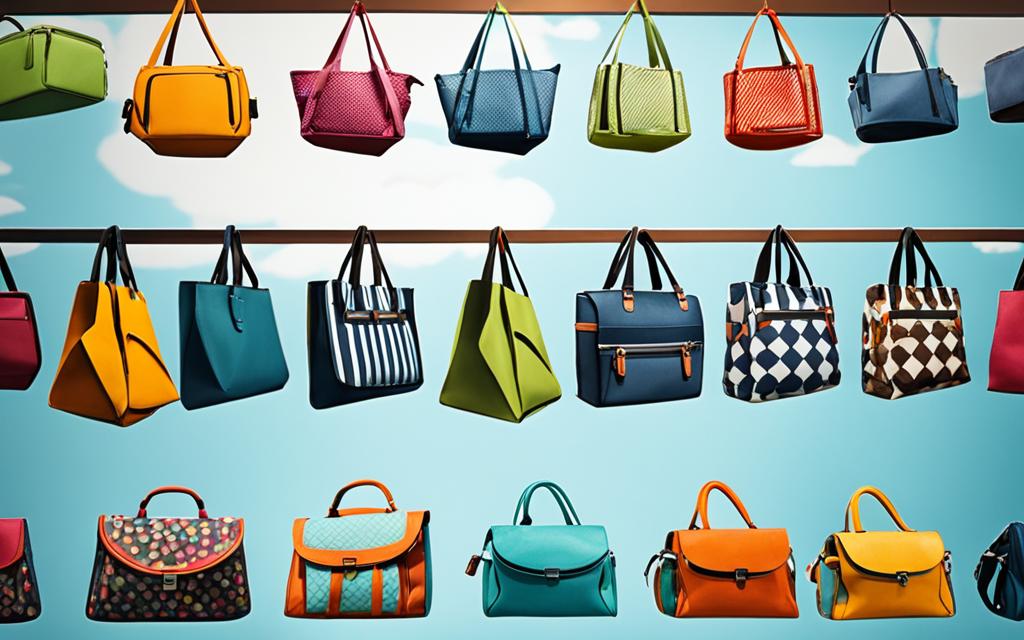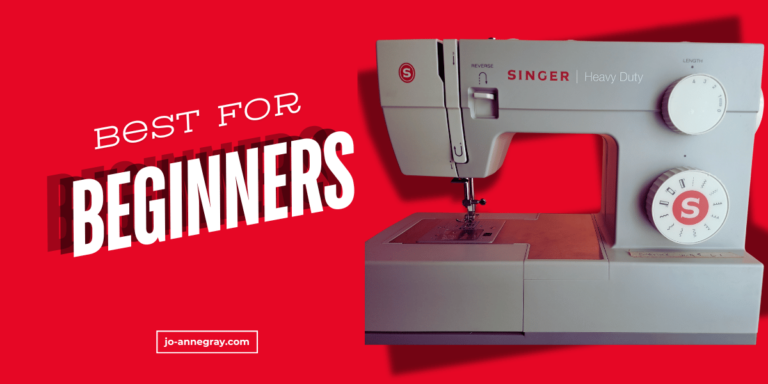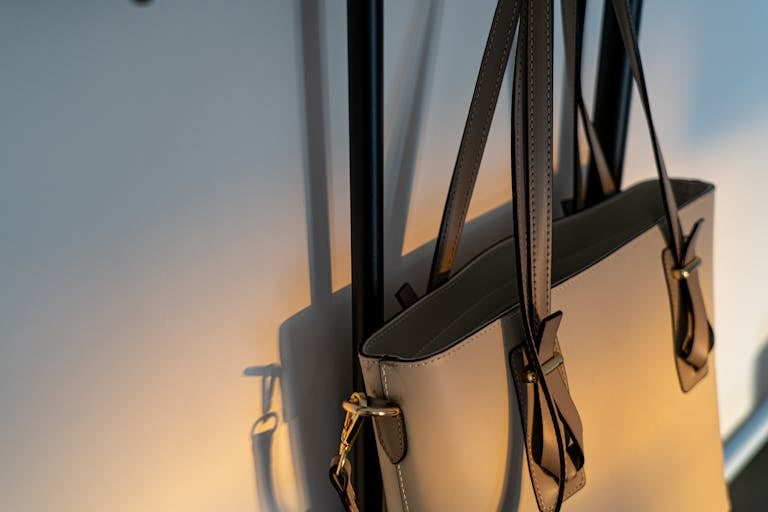Adding Easy Pockets and Compartments to Your Bags | DIY Guide
Do you wish your bag had more pockets and compartments, making it easier to find what you need? You’re in luck. This DIY guide will teach you how to enhance your bag. By adding pockets and compartments, your bag will be more organized and functional.
The moment I upgraded my tote bag is etched in my mind. It was no longer enough for me. Too often, I’d find myself digging for my essentials. So, I knew it was time for a change. I wanted my bag to organize my life and show off my personal touch.
Ready to turn your bag into a storage wonder? This guide offers everything you need. It covers adding key pockets for easy grabs, as well as secret spots for your treasures. No matter if you’re always on the go, hard at work, or creating, you’ll find ways to make your bag stylish and practical.
Key Takeaways
- Learn how to add pockets and compartments to your bags to maximize space and organization.
- Discover different types of pockets and compartments, each serving a unique purpose.
- Understand the design considerations for creating accessible, secure, and visually appealing pockets.
- Explore sustainable and durable construction techniques to ensure your bag modifications last.
- Unleash your creativity by adding custom features and personalized touches to your bags.
The Art of Adding Pockets and Compartments
Improving your bag’s usefulness is an art. The key is adding well-placed pockets and compartments. This trick turns a basic bag into something that’s both handy and personal. Pockets and compartments are key for keeping your stuff safe. They keep fragile and important items from getting damaged during daily use.
Enhancing Organization and Protection
Pockets and compartments keep your stuff nice and organized. This means you can find what you need in a flash. You’ll always have your keys, phone, or important papers close by. And, you won’t have to worry about these things getting damaged, thanks to these special spots.
Maximizing Bag Capacity
Smart pocket layouts also let you fit more stuff in your bag. You can carry everything from laptops to travel gear. This way, you can make your bag work just for you. It’ll keep looking neat while letting you bring along all your must-haves.
Types of Pockets and Compartments to Consider
When making your ideal bag, think about what pockets and compartments you need. They make your bag more useful and tidy. You’ll find places for everything, from things you use often to those you want to keep safe.
Exterior Pockets for Quick Access
Outer slip and patch pockets are great for quick-grab items like keys or your phone. These exterior bag pockets keep your main bag space neat. You won’t have to search deep in your bag for small things.
Interior Pockets for Added Security
Interior bag pockets are perfect for keeping important stuff like your wallet safe. They add an extra level of organization. It means you always know where your items are.
Specialized Compartments for Specific Items
You might need special places for certain things. Consider specialized bag compartments for your laptop or sunglasses. These spaces protect your special items and keep your bag arranged.
Hidden Pockets for Valuables
Hidden hidden bag pockets are great for keeping valuables safe and close. They’re perfect for things you want to protect discreetly. No one will know they’re there, but you.
Design Considerations for Pockets and Compartments
When you’re adding pockets and compartments to a bag, you need to think about a few important design elements.
You should first consider what the user needs. A camera bag, for example, requires different kinds of storage than a makeup bag does. It’s also crucial that the pockets and compartments are easy to access. This means placing them where you can get to your stuff quickly.
Determining Size and Shape
When designing pockets and compartments, size and shape are key. You want to keep items from moving too much but not be too tight. The right dimensions improve how well the bag carries things and how easy it is to use.
Selecting Closure Types
Choosing the right closure, like zippers or snaps, depends on how the bag will be used. This choice affects both access and security. A smart choice here can improve how well your bag’s compartments keep your things safe and easy to get to.
Ensuring Accessibility
Where you put the pockets and compartments matters a lot. The goal is to make sure you can easily find and use what’s inside. Quick-grab outer pockets and secure inside pockets both play key roles in how well the bag helps you stay organized and ready.
Understanding User Needs
Knowing what the bag user needs is crucial. Whether it’s for daily use or for trips, matching the bag’s features to these needs can make a big difference. It improves how well the bag works and how much the user likes it.

Materials and Construction Techniques
The materials and ways we build bags affect how long they last and how well they work. For example, pockets we use often outside might start to sag. To keep them tough, we need to add extra support so they don’t lose their shape over time.
The lining options for bag pockets are just as important for how we use them. If we pick bright linings, it’s easier to see what’s inside. This makes our bags more organized. Adding elastic to pockets can also help. It lets you fit different things better, so everything stays in place.
When we make construction techniques for bag pockets, details really matter. We need to sew right, reinforce weak spots, and choose the best materials. All of this makes sure our bag’s special parts last and work well for a long time.
| Reinforcement Techniques | Lining Options | Elastic Choices |
|---|---|---|
| Box stitching | Cotton canvas | Woven elastic |
| Bar tacking | Polyester twill | Knitted elastic |
| Interfacing | Nylon ripstop | Silicone-coated elastic |
It’s important to pick the right materials for bag pockets and compartments and how we put them together. Choosing carefully lets us make bags with strong, useful, and good-looking pockets. This makes our bags easier to use and more personal.
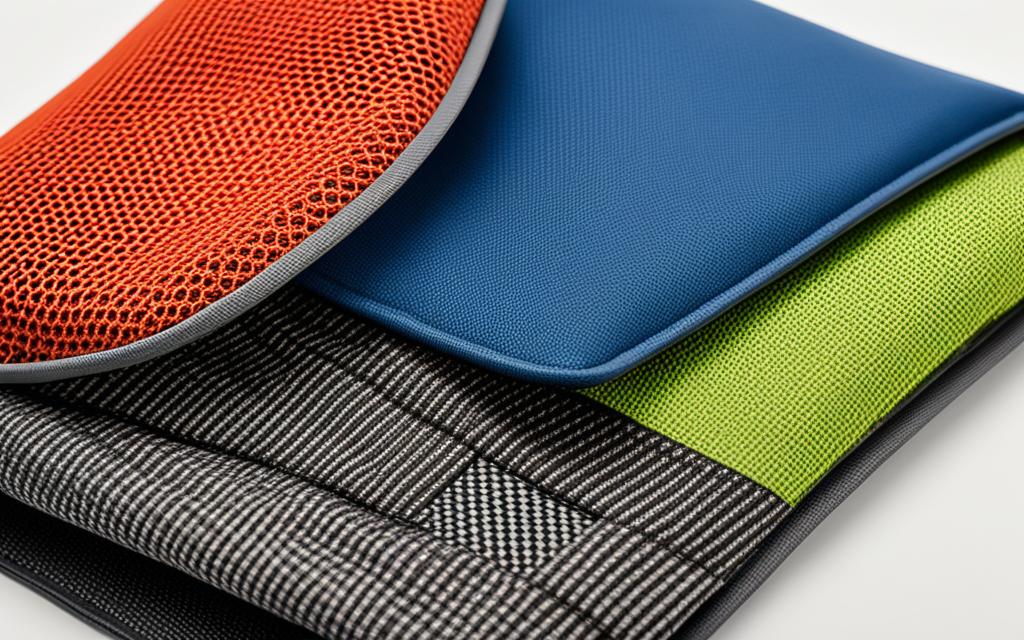
Adding Creative Flair to Your Pockets
Pockets and compartments are more than just functional. They can be a way to show off your style. Add fancy stitching or mix up different pocket styles for a unique look.
Decorative Stitching Designs
Change how your bag looks with decorative stitching designs for bag pockets. Mix bold patterns and bright thread colors to make your pockets pop. Or, try detailed embroidery to give your bag a personal touch.
Pleated or Ruffled Pockets
Pleated or ruffled bag pockets can make your bag stand out. They add fun or a feminine touch. By playing with folds, you can make your pockets dynamic yet functional.
Layering Multiple Pockets
Try layering multiple pockets on bags for a cool look. Stack pockets to make your bag more interesting. Mix shapes, sizes, and materials to create a bag that’s totally you.
Overcoming Challenges in Pocket Construction
Adding pockets to bags can make them more useful. But, there are some hurdles to leap. We must avoid making the bags too bulky or complex. This keeps them easy on the eyes and light to carry.
Strike a balance to make your bag both functional and good-looking. Careful planning of pocket sizes and placements is key. Such design choices reduce the risk of a bulky or messy look.
Ensuring Durability for Heavy-Duty Use
Durability is a must, especially for pockets that will hold heavy things. Think of laptops or water bottles. They need pockets that won’t sag or tear. Using strong materials and techniques like double-stitching helps your pockets last.
Maintaining Aesthetic Appeal
Making your bag look good with pockets isn’t easy. It’s all about how the pockets fit into the design. They should enhance the bag’s style, not take away from it. Make sure the pockets’ design, size, and placement match the overall look.
By taking on these challenges, your bag will be organized, versatile, and a style statement. It’s not just about what your bag can do. It’s also about how good it looks while doing it.
Adding Pockets and Compartments to Your Bags
Want to make your bags more useful and unique? Adding pockets and compartments is key. It can make your daily stuff more organized, or tailor your bag to fit your needs. This part gives an overall look at what you’ll do. It’s a bridge from previous ideas to hands-on steps.
Starting to customize your bag means figuring out what you need. Do you need quick access to some items? Want a secure spot for valuables? Knowing this helps pick the right pockets and where to put them.
After knowing what’s needed, it’s time to make changes. Maybe you’ll sew new pockets or add zippers. These changes can feel good and give you a sense of accomplishment. The next parts will show you how to do it.
Adding pockets isn’t just for neatness and more space. It’s also a chance to show your style. By customizing your bag, you make something that’s totally you. This can make using your bag every day even more fun.
Sustainable Pocket and Compartment Solutions
Finding ways to make your bags unique while being kind to the planet is crucial. Let’s talk about using green materials and reducing waste through upcycling. This way, any changes you make to your bags will show you care about our Earth.
Eco-Friendly Materials
Choose sustainable options like organic cotton or recycled fabrics for your bag parts. These materials help to lessen harm to the environment and add a natural look to your bag. Without a doubt, picking sustainable materials for bag pockets means you’re making a difference in a greener world.
Reducing Waste with Upcycling
Want to go a step further for our Earth? Try upcycling for bag pockets. You can make pockets from leftover fabric, reducing trash and adding a special look to your bag. This unique step shows your deep care for the planet.
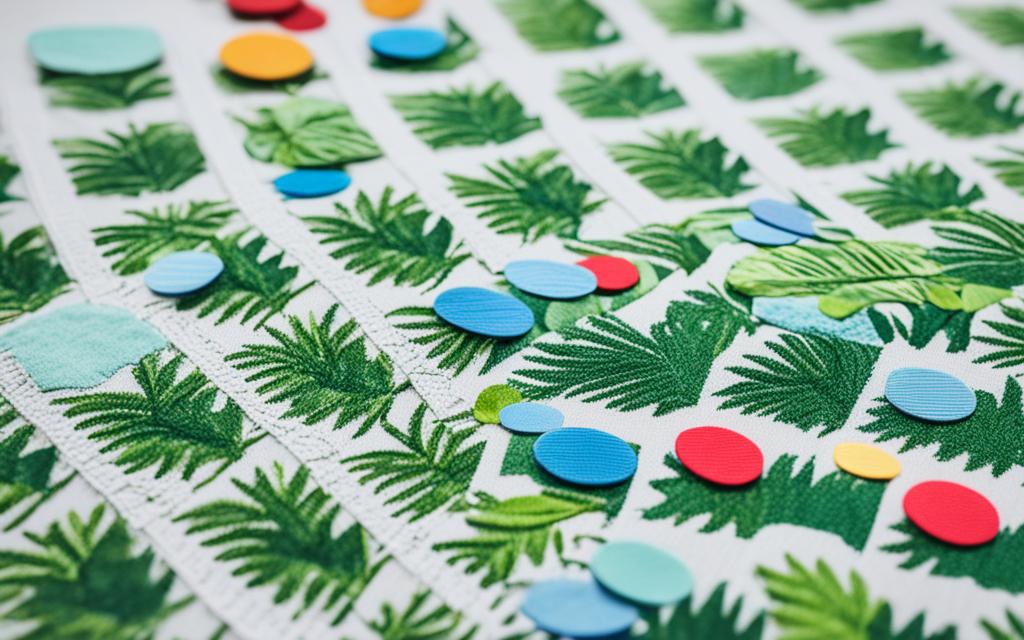
Step-by-Step Pocket Construction Tutorials
Unleash your creativity. Change your bags with custom pockets. This section will show you how to add pockets to bags, create DIY pocket tutorials for bags, and sew pockets on bags. You’ll learn to construct different types of pockets for bags.
Creating a Simple Slip Pocket
A slip pocket is simple and useful. Here’s how you add one to your bag:
- Measure your pocket size on the bag. Cut a piece of fabric a little bigger.
- Fold the fabric in half, faces together. Sew three edges, keeping a small gap for flipping inside out.
- Turn the fabric right-side out and flatten. Sew along the edges for a neat finish.
- Put the pocket on your bag. Pin it or baste it in. Sew it on well.
Adding a Patch Pocket with Zipper
Want something fancier? Try a patch pocket with a zipper. Here’s what to do:
- Cut out a pocket-sized fabric piece.
- Choose a zipper shorter than the fabric width. Sew it on, half an inch from the edge.
- Fold the fabric, faces together, and sew up the sides and bottom. Leave the top open.
- Turn it inside out and flatten. Add a topstitch for a clean edge.
- Put it on your bag. Pin it or baste it on. Make sure it’s sewn down tight.
Sewing an Elasticized Pocket
Elasticized pockets can hold various-sized items. They stretch. Follow these steps:
- Figure out your pocket size and cut the fabric.
- Cut a elastic strip short of the fabric’s width.
- Sew the elastic on the top, stretching it a little as you go.
- Fold the fabric, faces together, and sew the sides and bottom. Keep the top open.
- Flip the pocket right-side out. Press it flat and topstitch for a clean finish.
- Put it on your bag. Pin or baste it first. Sew it down securely.
Constructing an Exterior Cargo Pocket with Gusset
Need a big outside pocket? Try making a cargo pocket with a gusset:
- Measure and cut the front pocket fabric.
- Cut two pieces bigger than the pocket’s opening for the gusset.
- Sew the gusset pieces on, making a box shape.
- Fold the pocket, faces together, and sew up the sides and bottom. Leave the top open.
- Turn it right-side out. Flatten and topstitch for a neat look.
- Put it on your bag. Pin or baste it. Sew it securely.
These tutorials will guide you. You’ll learn to sew pockets on bags and create different types of pockets for bags. Make your bags special, showing off your creativity.
Inspiration and Ideas for Pockets and Compartments
Enhancing the use and look of your bags is fun. The process starts with finding inspiration for bag pockets and compartments. Look into how you can customize bag features to meet your needs and reflect your style.
Kate Spade is a brilliant example. Her bags are famous for their personalized bag designs. They marry form with function well. You’ll find her totes have clever pockets inside and out for easy organization.
Looking for something unique? Check out Etsy and its artists. They modify bags in cool ways. You’ll discover bags with clever pockets and hidden areas. They turn regular bags into exceptional pieces.
| Inspiration Source | Unique Pocket and Compartment Ideas |
|---|---|
| Fashion Runway Shows | Oversized exterior pockets, convertible compartments, and multi-functional bag designs |
| Vintage and Antique Bags | Concealed pockets, compartmentalized interiors, and specialized storage solutions |
| Outdoor and Adventure Gear | Cargo pockets, water-resistant compartments, and expandable storage options |
| DIY Craft Tutorials | Unique pocket shapes, decorative stitching, and customizable organizational systems |
By diving into these ideas, you can make your bags truly personal. They’ll be perfect reflections of your style and usage needs.
Conclusion
Adding pockets and compartments can turn a simple bag into something special. This guide showed you how to make your bag work better for you. You learned why it’s important to tweak your bag’s design to fit your needs.
The benefits of personalized bag designs are clear. With the right features, you can easily find what you need, protect your stuff, and fit more without looking bulky. The magic often lies in the intricate details, meeting your exact needs and tastes.
Customizing your bag is not just for better use; it lets you show who you are. You can add unique touches like fancy stitching to make your bag stand out. This is your chance to make your bag reflect you and your lifestyle.
Keep exploring ways to make your bag perfect for you. Using what you’ve learned here, you can make a bag that is truly yours. The importance of customizing bag features is big. It makes your bag fit your life like it was made just for you.
Source Links
- https://www.incolororder.com/2018/08/workshop-tote-sew-along-how-to-add.html
- https://www.patternpile.com/sewing-patterns/maximizing-functionality-the-art-of-adding-pockets-compartments-to-bag-designs-video-tutorials
- https://www.reddit.com/r/myog/comments/lcgaez/adding_internal_organisation_to_a_backpack/

